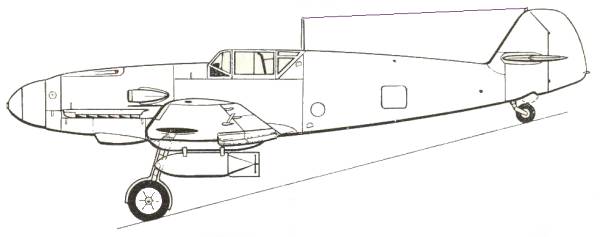The
Bf 109F series was the result of the Augsburg design team's program of
aerodynamic refinement to the basic 109 design to take advantage of
increases in power promised by improved versions of the DB 601 engine.
Those changes brought the design to the peak of its development at
least from the handling and performance standpoint. Later versions
would increase in weight without increases in lift and only marginal
increases in power resulting in a deterioration in handling
characteristics.
The first F-1's left the production lines in November of 1940. Several
crashes followed introduction into service evaluation units and it was
found that the tail plane, now void of the bracing struts used on the E
models was susceptible to high frequency vibrations at certain engine
speeds causing structural failure. Stiffening plates were added to
solve
this problem. The F-2 was identical to the F-1 with the exception of
the engine mounted cannon which was an MG FF/M on the F-1 and an MG 151
on the F-2. The arrival of the Bf 109F on the Channel Coast prevented
the Spitfire V from gaining the edge. While it could still out turn the
109, the 109 could out climb and out dive the latest version of the
Spitfire. The F-3 version appeared around the beginning of
1942
as a result of the availability of the DB 610E engine which used 87
octane fuel instead of the 96 required for the 601N used in the -1 and
-2. The -4 version, produced almost simultaneous with the -3, differed
primarily in the caliber of the engine mounted MG 151 which was
increased to 20-mm. Ammunition capacity was reduced from 200 to 150
rounds. Improved self sealing was applied to the fuel tank and pilot
protection was revised comprising the usual armored windscreen, an
armored glass rear head shield below which was a 6-mm. armor plate to
protect the pilots neck and shoulders, a rectangular 5-mm. plate also
being mounted above the armored glass shield mounted at 45º to
protect the top of the pilots head.
During the first few weeks of 1942 a fighter bomber version, the F-4/B
began service status and appeared on the Channel Coast shortly after.
The F-4/B differed little from the standard fighter version apart from
having a bomb fusing battery box installed in the fuselage and a
ventral ETC 250 bomb carrier for a single SC 250 bomb.
Tip
and Run
Tip and run was the name given to method of attack that the Luftwaffe
developed in early 1941 and consisted of fighter bombers flying across
the English Channel at wave top height to avoid British radar, then as
they approached their target they would climb to 500 meters, level off
then dive on their target at a 3º angle and lob their bomb at
the
target. An Adjutant with II./JG 2, Oblt. Frank Liesendahl, while
recovering from injuries as a result of being shot down over Dunkirk,
put his experience and tactics as a Jabo pilot onto paper and convinced
the Geschwader Kommodore, Major Walter Oesau of the benefits of having
a dedicated and independent Jabostaffel. Prior to this these attacks
had been carried out by regular fighter pilots rather than those
trained in ground attack principles. This resulted in 13./JG 2 being
created in November of 1941 with Liesendahl in command. Initially
shipping was the primary target with a number of successes. Targets
were
later widened to include port facilities, gasometers and other targets
of strategic importance. This eventually lead to a wide open policy of
attacking any target including civilians as a means of demoralizing the
British public. In spite of the fact that the number of aircraft
available for these operations rarely exceeded 30, British efforts to
prevent these attacks were taxed all out of proportion to the smallness
of the German effort and never were successful in preventing them.
13./JG 2 was later re designated 10.(jabo)/JG 2.
It was reading about these attacks and seeing a color profile, printed
in a book on ground attack aircraft, of Frank Liesendahl's Bf 109F that
influenced to want to build a model of it. The aircraft carried the
emblem of 10.(jabo)/JG 2. which was a fox with a ship in its jaws and
several of the staffel aircraft carried marking on their tails
indicating the number of ships that the staffel had attacked, damaged
and sunk. Frank Liesendahl's aircraft, blue 1, was the one I
chose to model.
The Kit
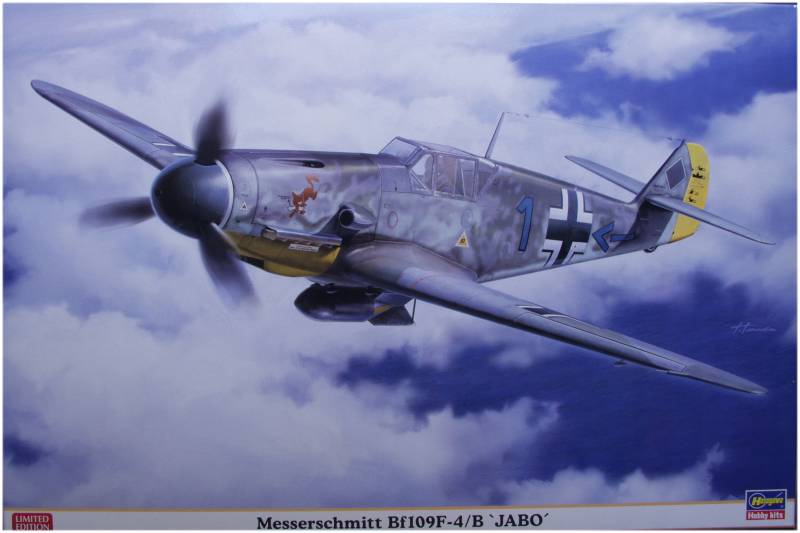
The Hasegawa kit comes
in a two part top open box of typical size for their 1/32 fighters with
their usually nice artwork on the top. Inside the box one finds
one large sealed bag with three sprues of parts molded in light gray.
Another sealed bag has three smaller sprues also molded in gray and
these sprues contain mostly parts specific to the 'F' variant. Another
sealed bag contains the clear parts and a small bag contains some resin
parts. One very small bag contains self adhesive metal foil pieces used
to represent the reinforcing plates added to the tail section. This was
a limited addition kit so some of the parts contained apply only to
this kit.
The parts are typical of Hasegawa of late (the kit has a 2012 date
on it) perfectly molded with no hint of flash, a glossy finish, finely
engraved panel lines and fastener and rivet detail and raised detail
where applicable. Compared to some of their other 109 kits this
one has the fuselage molded in one piece and has all the correct panels
for an 'F' model. They also corrected the spinner which was an issue in
the 'G' version kit and provided the correct propeller blades. The
fuselage has some molded on detail in the cockpit area and there is
some additional detail parts to be added but there are also some
ejector marks that will show if not removed. The instrument panel has
nice raised detail for the dials and the instrument faces. The main
flight control surfaces are molded in the neutral position but the
flaps and cooling flaps are molded separately as are the leading edge
slats. The fabric control surfaces have rib tapes with simulated
stitching which may be a bit heavy but looks OK to me. The inside of
the upper surfaces of the wing have gear bay detail molded in and the
lower wing half as the wheel bay enclosure molded in. A wing spar is
included which will set the dihederal correctly. The tires aren't
weighted but they do have separate inner and outer hubs which makes
painting a lot easier. The landing gear struts have the brake lines
molded on.
Ejector pin marks also show up on the inside of the gear doors but will
be mostly hidden behind the struts. They are also present on the
insides of the flaps and radiator flaps although these are not likely
to be all that visible unless you display them fully open. The kit also
contains a relatively nice pilot figure with three separate heads, one
with no headgear, one with helmet and one with helmet and oxygen mask.
The propeller has separate blades but they have alignment pins to set
the angle correctly. The engine exhaust stacks are molded individually
rather than as a single strip and the ends are slightly hallowed out. I
found no surface defects on any of the airframe parts and the mold
parting lines on parts so effected were light. So lets take a look at
the sprues.
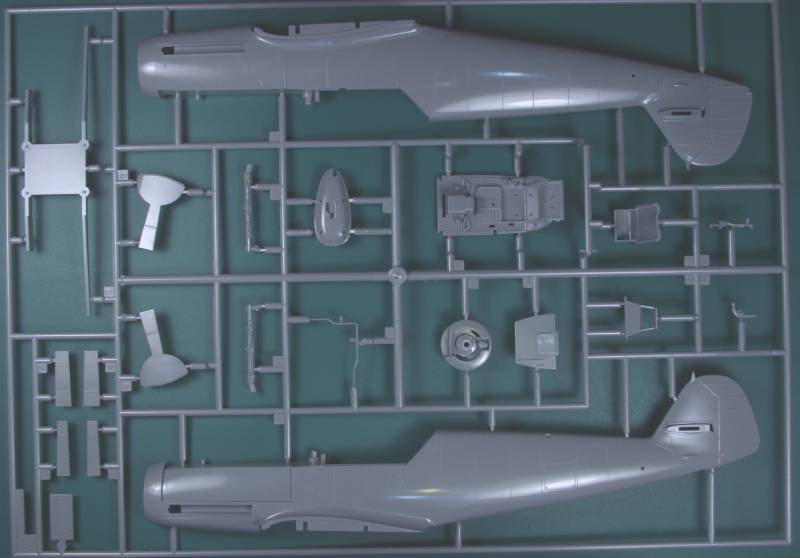
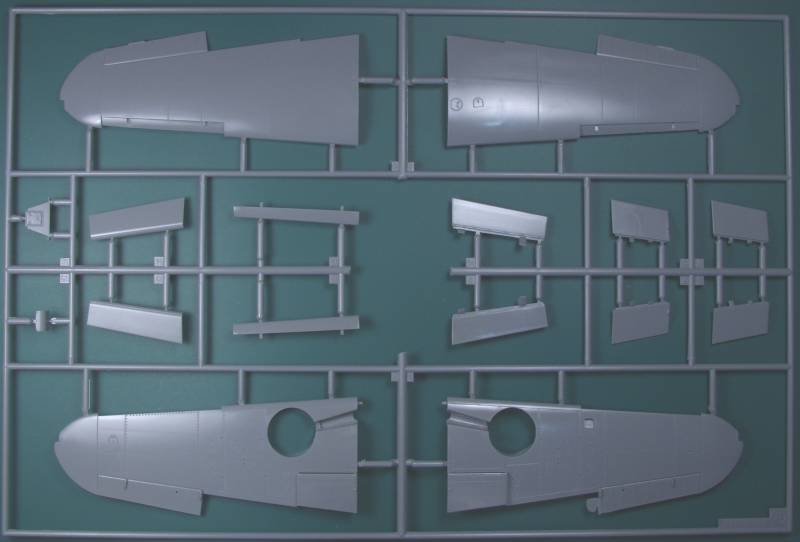
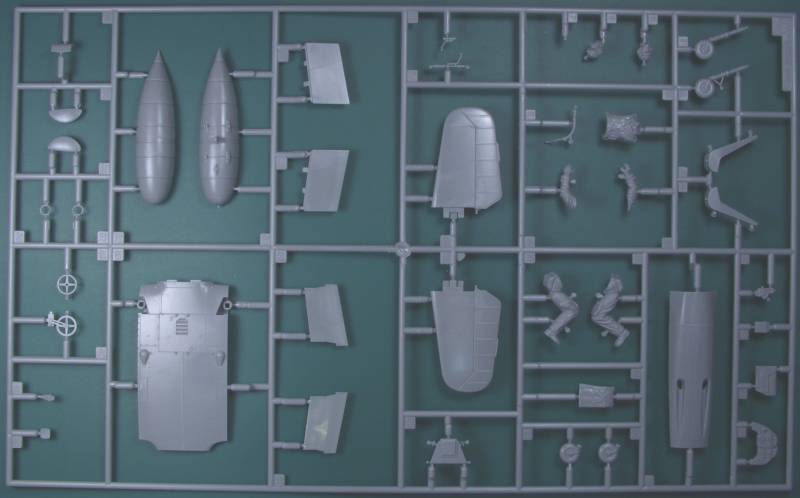
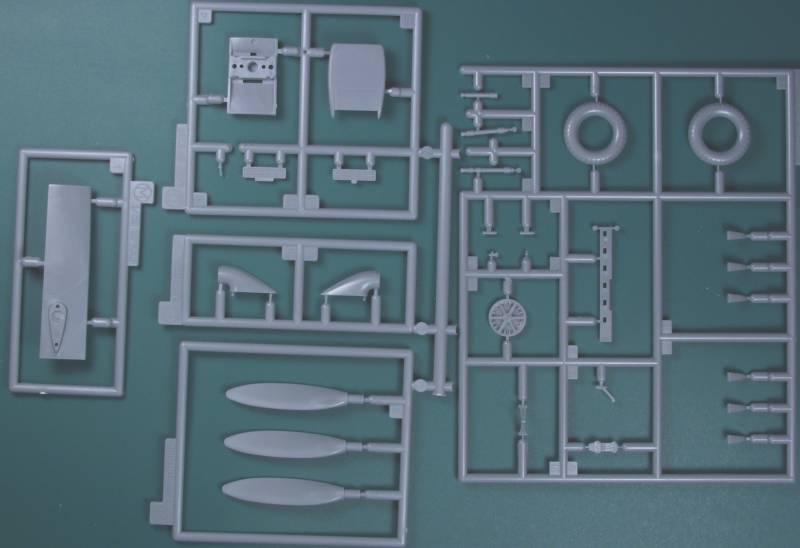
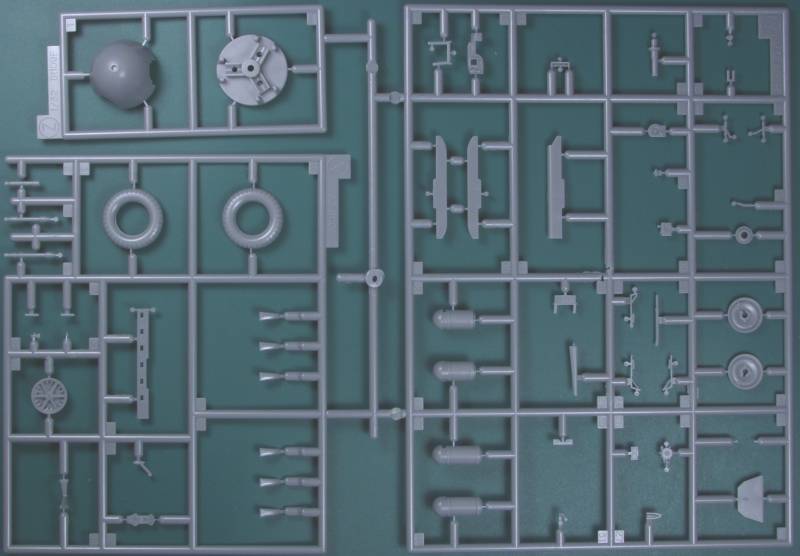
The kit contains some resin parts which are for the bomb and bomb rack.
The bomb body is molded as one piece with half of the fins being
separate is nicely done and one needs only to clean up the mold parting
line and a couple small pour gates. The rack just needs the gates
removed and cleaned up. Both the bomb and the rack had a lot of
extremely small air bubbles on the surface in places. They may be small
enough that primer will fill them. The ones on the rack will be hard to
see with the bomb in place, the ones on the bomb may be more noticeable.
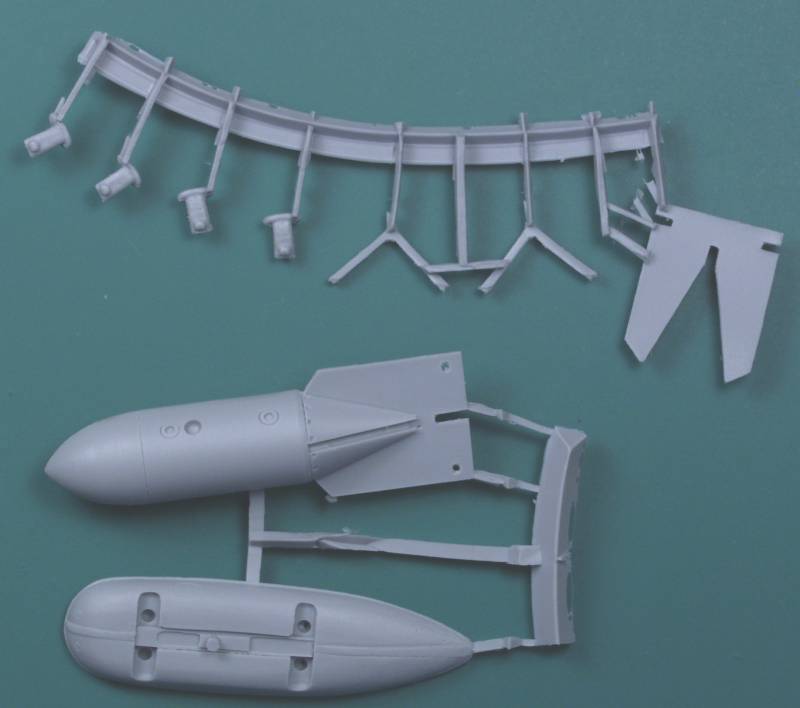
The clear parts are thin and fairly optically clear. There are a number
of extra parts to satisfy a number of different versions. Also included
are wingtip nav lights and clear armor glass for behind the pilot.
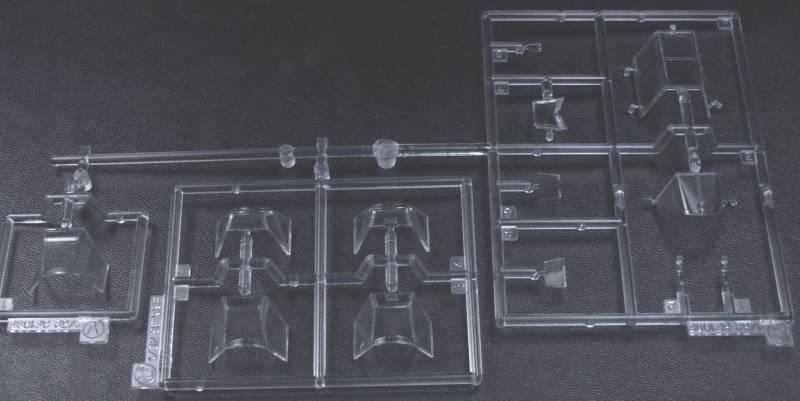
The decals look reasonably thin are in register and appear opaque.
Amazingly the sheet contains complete swastika's. A fairly large number
of stencils are provided along with seat belts and harness although
they seem an odd color and style for German belts and a decal for the
instrument panel. The sheet has markings for three different aircraft.
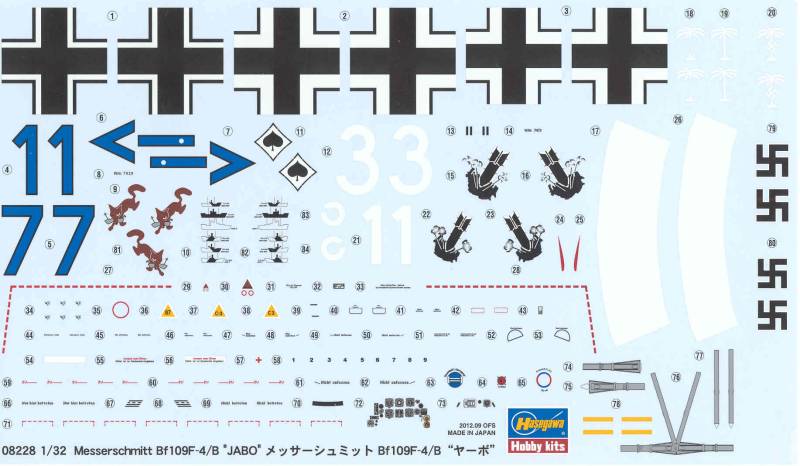
The instructions are are typical Hasegawa, one long sheet folded to
create 8 panels. One panel has the history in English and Japanese and
a color chart with generic names, RLM numbers where applicable and
reference numbers for GSI Creos aqueous and Mr. Color paints. Assembly
is done in 15 steps spread across three panels. Another panel has a
parts map with parts not used darkened out and also the assembly of the
bomb. Two panels have the painting and marking instructions and the
last panel has instructions for installing decals, the metal foil
parts, cleaning and prepping the resin parts and the usual safety
warning.
After
Market
Goodies
Eduard has both exterior
detail (32266) interior color (32682) and color Zoom (33075) and a mask
set (JX116) I suspect there are other items if you search for them.
Conclusions
This is another nice
and well executed kit by Hasegawa and if you follow the instructions
you will be rewarded with an excellent model. Recommended for almost
all skill levels.
Links to kit build or
reviews
A review / build can be
found here. Note: This is not this specific special addition but the
basic kit is the same.
References
Warplanes
of the Third Reich by William Green
Schlachtflieger
- Luftwaffe Ground-Attack Units 1937 - 1945 by J. Richard Smith, Chris
Goss, Martin Pegg, Andrew Arthy, Nick Beal and Robert Forsyth
Back to
the Misc German page
Updated
9/21/14


